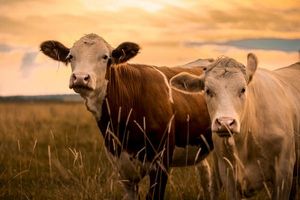LRP or LGM: A win-win for livestock ranchers and producers
Bringing stability to market volatility
 Declining market prices and shrinking margins are two of the primary threats to ranchers and livestock producers. This is by no means groundbreaking news. There are, however, ways to safeguard your operation against these threats that warrants consideration.
Declining market prices and shrinking margins are two of the primary threats to ranchers and livestock producers. This is by no means groundbreaking news. There are, however, ways to safeguard your operation against these threats that warrants consideration.
Two insurance policy options supported by the Federal Livestock Program can help protect livestock profitability against market volatility: Livestock Risk Protection (LRP) and Livestock Gross Margin (LGM). With the fluctuation in the live market due to foreign imports, retail price resistance and political pressure, these two policies take the guessing game out of an often-unstable market.
“For ranchers and producers that are constantly fighting for pull in the market, livestock protection can give them that bottom line point and peace of mind,” said Todd Kluser, ProAg Senior District Sales Manager. “It helps provide a guarantee of the continuation of your operation by securing a minimum price lock (LRP) or margin (LGM).”
What is the difference between these two policy options and how do they work? More importantly, which is right for your livestock operation? Let’s start with some simple definitions.
What is Livestock Risk Protection (LRP)?
What it covers: LRP covers a drop in the market price (based on USDA’s Agricultural Marketing Service) and is available for fed cattle, feeder cattle, swine and lambs.
How it works: Producers secure a floor market price, based on national CME Group futures, for a certain number of head and for a specified period. Think of this like a put option with the benefit of still leaving your upside price potential open. If at the end of the period, RMA determines the ending value is below your policy’s floor price, you may qualify for an indemnity payment for the difference between the coverage price and ending value.
What is Livestock Gross Margin (LGM)?
What it covers: LGM provides protection against the loss of gross margins caused by a drop in animal market prices or increase in feed market prices and is available for yearling and calf-finishing operations, dairy and swine.
How it works: For cattle and swine producers, LGM protects against loss of gross margin — the market value of livestock minus feeder cattle and feed costs. In dairy producers, it provides protection if feed costs rise, or milk prices drop.
What are the biggest differences between LRP and LGM?
Beyond how coverage is determined (market price versus gross margins), there are additional components that differentiate the two policy options. Recapping the earlier note, LRP has no minimum head limit, making it ideal for smaller producers, and maximum limits for number of head covered: 12,000 annually for feeder or fed cattle (6,000 per endorsement), 150,000 for swine (40,000 per endorsement) and 28,000 for lamb (2,000 per endorsement). On the other hand, LGM has no head limits whatsoever, making it an attractive option for all operations.
While producers can lock in prices through the futures market, using the futures market requires a contract for a sizable number of animals or pounds. On the other hand, both LRP and LGM offer price protection on any number of animals. Whitney Redig, ProAg District Sales Manager, said this flexibility when selecting coverage ensures operations of all sizes can get the livestock protection that is right for them.
Recent changes to LRP and LGM
With LRP, the premium is now due at the end of coverage, versus the “pay upfront” method of yesteryear. This allows ranchers/producers to pay once they have earned money on their livestock or even subtract it from their indemnity from the total payment. In addition, LRP now allows producers to sell livestock 60 days prior to the policy end date, compared to 30 days out prior to 2021.
Starting in the 2022 crop year, producers can select LGM coverage weekly instead of only one time per month. “This is really a pivotal change as it gives ranchers and producers even more flexibility in managing risk for their operation,” said Jacqueline Da Rocha, ProAg Western Region Senior District Manager.
Proudly rooted in agriculture and with a claims process founded on speed and accuracy, ProAg is your preferred partner for livestock protection. For more information on Livestock Risk Protection or Livestock Gross Margin, contact your ProAg agent or nearest ProAg regional office.
